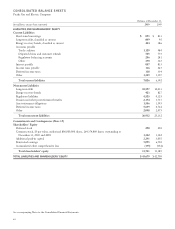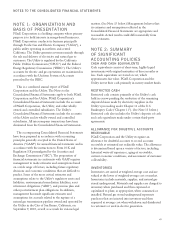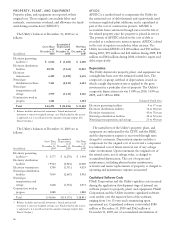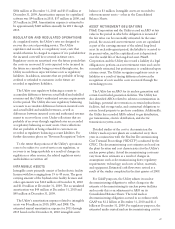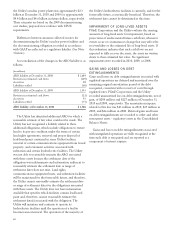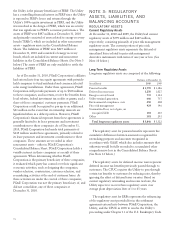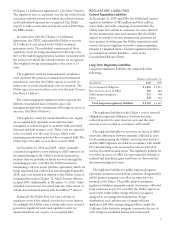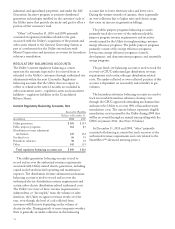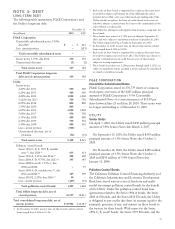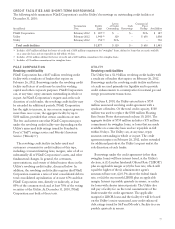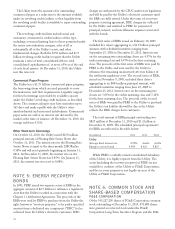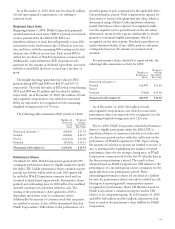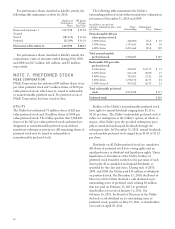PG&E 2010 Annual Report Download - page 76
Download and view the complete annual report
Please find page 76 of the 2010 PG&E annual report below. You can navigate through the pages in the report by either clicking on the pages listed below, or by using the keyword search tool below to find specific information within the annual report.
the Utility is the primary beneficiary of PERF. The Utility
has a controlling financial interest in PERF since the Utility
is exposed to PERF’s losses and returns through the
Utility’s 100% equity investment in PERF, and the Utility
was involved in the design of PERF, which was an activity
that was significant to PERF’s economic performance. The
assets of PERF were $897 million at December 31, 2010
and primarily consisted of assets related to energy recovery
bonds (“ERBs”), which are included in other noncurrent
assets – regulatory assets in the Consolidated Balance
Sheets. The liabilities of PERF were $827 million at
December 31, 2010 and consisted of energy recovery
bonds, which are included in current and noncurrent
liabilities in the Consolidated Balance Sheets. (See Note 5
below.) The assets of PERF are only available to settle the
liabilities of PERF.
As of December 31, 2010, PG&E Corporation’s affiliates
had entered into four tax equity agreements with privately
held companies to fund residential and commercial retail
solar energy installations. Under these agreements, PG&E
Corporation will provide payments of up to $300 million
to these companies, and in return, receive the benefits from
local rebates, federal investment tax credits or grants, and a
share of these companies’ customer payments. PG&E
Corporation could be required to pay up to an additional
$41 million in the event that its ownership interests are
liquidated when in a deficit position. However, PG&E
Corporation’s financial exposure from these agreements is
generally limited to its lease payments and investment
contributions to these companies. As of December 31,
2010, PG&E Corporation had made total payments of
$149 million under these agreements, primarily related to
its lease payments and investment contributions to these
companies. These amounts are recorded in other
noncurrent assets – other in PG&E Corporation’s
Consolidated Balance Sheet. PG&E Corporation holds a
variable interest in these companies as a result of these
agreements. When determining whether PG&E
Corporation is the primary beneficiary of these companies,
it evaluated which party has control over their significant
economic activities, such as designing the companies,
vendor selection, construction, customer selection, and
re-marketing activities at the end of customer leases. As
these activities are under the control of these companies,
PG&E Corporation was not the primary beneficiary of, and
did not consolidate, any of these companies at
December 31, 2010.
NOTE 3: REGULATORY
ASSETS, LIABILITIES, AND
BALANCING ACCOUNTS
REGULATORY ASSETS
Current Regulatory Assets
At December 31, 2010 and 2009, the Utility had current
regulatory assets of $599 million and $427 million,
respectively, consisting primarily of price risk management
regulatory assets. The current portion of price risk
management regulatory assets represents the deferral of
unrealized losses related to price risk management
derivative instruments with terms of one year or less. (See
Note 10 below.)
Long-Term Regulatory Assets
Long-term regulatory assets are composed of the following:
Balance at December 31,
(in millions) 2010 2009
Pension benefits $ 1,759 $ 1,386
Deferred income taxes 1,250 1,027
Energy recovery bonds 735 1,124
Utility retained generation 666 737
Environmental compliance costs 450 408
Price risk management 424 346
Unamortized loss, net of gain, on
reacquired debt 181 203
Other 381 291
Total long-term regulatory assets $ 5,846 $ 5,522
The regulatory asset for pension benefits represents the
cumulative differences between amounts recognized for
ratemaking purposes and amounts recognized in
accordance with GAAP, which also includes amounts that
otherwise would be fully recorded to accumulated other
comprehensive loss in the Consolidated Balance Sheets.
(See Note 12 below.)
The regulatory assets for deferred income taxes represent
deferred income tax benefits previously passed through to
customers. The CPUC requires the Utility to pass through
certain tax benefits to customers by reducing rates, thereby
ignoring the effect of deferred taxes on rates. Based on
current regulatory ratemaking and income tax laws, the
Utility expects to recover these regulatory assets over
average plant depreciation lives of 1 to 45 years.
The regulatory asset for ERBs represents the refinancing
of the regulatory asset provided for in the settlement
agreement entered into between PG&E Corporation, the
Utility, and the CPUC in 2003 to resolve the Utility’s
proceeding under Chapter 11 of the U.S. Bankruptcy Code
72


